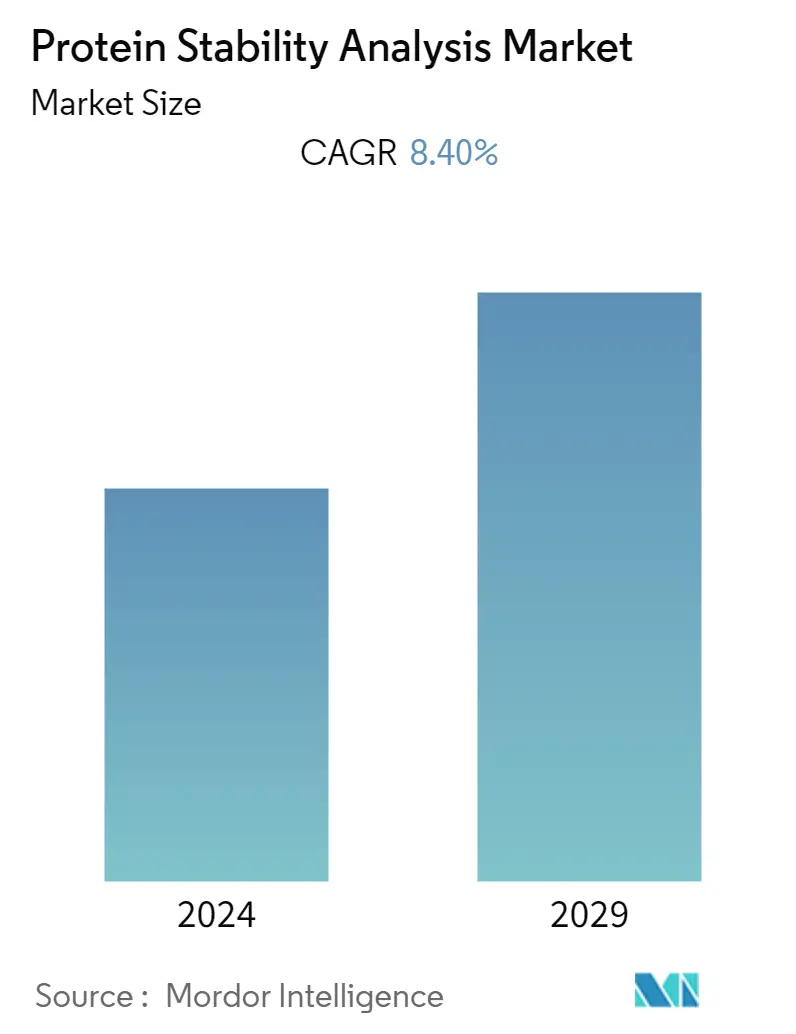Market Size of Protein Stability Analysis Industry

| Study Period | 2021 - 2029 |
| Base Year For Estimation | 2023 |
| CAGR | 8.40 % |
| Fastest Growing Market | Asia Pacific |
| Largest Market | North America |
| Market Concentration | Medium |
Major Players
*Disclaimer: Major Players sorted in no particular order |
Protein Stability Analysis Market Analysis
The protein stability analysis market is expected to register a CAGR of 3.5% during the forecast period.
COVID-19 had a significant impact on the protein stability analysis market in the initial phase since protein stability studies were conducted to assess the structure and nature of the COVID-19 virus to a great extent which helps gain a better understanding of the virus and supports the development of effective and efficient therapeutics. For instance, as per the article published in September 2022 in Stanford Medicine, elevated virus levels in the blood of COVID-19 patients in hospitals predicted the worsening of respiratory symptoms and suggest ongoing viral replication in advanced disease stages. A protein of the virus that causes COVID-19 was measured in the patient's blood during the test. Hence, such analysis showing the complications associated with COVID-19 through protein analysis will likely boost the market growth.
In the post-pandemic era, studies are still being conducted due to the emergence of different COVID-19 mutants. Since the beginning of the pandemic, the WHO has described eight variants of interest (VOIs), namely Epsilon, Zeta, Eta, Theta, Iota, Kappa, Lambda, and Mu. Currently, studies are being conducted to determine whether mutants of Omicron variants affect the virus's properties, speed of spreading, the severity of the associated disease, the performance of vaccines, or other public health and social measures and hence, the demand for protein analysis products is expected to increase. Another factor to account for are the Sars-COV-2 strains which are expected to have a positive impact on the market over the forecast period.
Factors such as rising research and development expenditure of pharmaceutical and biopharmaceutical companies, increasing proteomics and genomics research activities, and an increasing number of recombinant protein therapeutics and biologics are expected to drive the market growth over the forecast period since research studies require protein stability assessments to substantiate the results.
For instance, as per the EFPIA 2022 report, in 2021, Europe invested an estimated EUR 41,500 million (about USD 35,109 million) in pharmaceutical R&D. Thus, huge investments in R&D drive the growth of the protein stability analysis market during the forecast period. Furthermore, investments and financing in genomic research activities are projected to fuel the market as researchers seek opportunities in protein stability studies. For instance, in September 2022 NHGRI, part of the NIH, planned to fund USD 3.35 million over five years to launch the Genome Research Experiences to attract researchers into the Genomics Field to Enhance Diversity (GREAT) program. Moreover, in September 2022, a joint venture by the University of Western Australia and Proteomics International, which conducts vital work in medical, environmental, and agricultural testing of proteins received a funding of USD 2 million . The money is likely to enable the WA Proteomics Facility to upgrade its automated tools and staff, increasing output capacity to hundreds of samples.
As a result of the increase in pharmaceutical and biopharmaceutical companies' R&D expenditures, as well as the increase in the number of proteomics and genomics research activities, the protein stability analysis market is anticipated to witness growth over the forecast period. However, the high cost of protein stability analysis systems is expected to restrain the growth of this market to a certain extent.
Protein Stability Analysis Industry Segmentation
As per the scope of the report, protein stability is the net balance of forces, which determines whether a protein will be its native folded conformation or a denatured (unfolded or extended) state. Protein stability analysis instruments are used to determine protein stability. The Protein Stability Analysis Market is segmented by Product (Reagents and Assay Kits, Instruments, Consumables and Accessories, and Others), Technique (Chromatography, Spectroscopy, Surface Plasmon Resonance, Differential Scanning Calorimetry, Differential Scanning Fluorimetry, and Other Techniques), End-User (Pharmaceutical & Biotechnology Companies, Academic and Research Organizations) and Geography (North America, Europe, Asia-Pacific, Middle East, and Africa, and South America). The market report also covers the estimated market sizes and trends for 17 countries across major regions globally. The report offers the value (in USD million) for the above segments.
| By Product | |
| Reagents and Assay Kits | |
| Instruments | |
| Consumables and Accessories | |
| Other Products |
| By Technique | |
| Chromatography | |
| Spectroscopy | |
| Surface Plasmon Resonance | |
| Differential Scanning Calorimetry | |
| Differential Scanning Fluorimetry | |
| Other Techniques |
| By End-User | |
| Pharmaceutical & Biotechnology Companies | |
| Academic and Research Organizations |
| Geography | ||||||||
| ||||||||
| ||||||||
| ||||||||
| ||||||||
|
Protein Stability Analysis Market Size Summary
The protein stability analysis market is poised for growth, driven by increasing research and development activities in the pharmaceutical and biopharmaceutical sectors. The market's expansion is supported by the rising demand for proteomics and genomics research, as well as the growing number of recombinant protein therapeutics and biologics. The COVID-19 pandemic initially impacted the market significantly, as protein stability studies were crucial in understanding the virus and developing therapeutics. The ongoing emergence of COVID-19 variants continues to fuel demand for protein analysis products. Despite the high cost of protein stability analysis systems posing a challenge, advancements in techniques such as differential scanning calorimetry (DSC) are expected to propel market growth. DSC's ability to characterize protein stability efficiently makes it a preferred choice in research and development, particularly in drug discovery.
The market landscape is characterized by the presence of numerous global and regional companies, contributing to its fragmented nature. Key players include Agilent Technologies Inc, NanoTemper Technologies, Shimadzu Corporation, Thermo Fisher Scientific, and Spectris PLC (Malvern Panalytical Ltd). These companies are actively innovating and expanding their product offerings to enhance market presence. For instance, Agilent Technologies recently launched advanced mass spectrometry instruments, while Linseis Messgeräte GmbH introduced a cost-effective differential scanning calorimeter. The North American region, with its substantial investments in genomic and proteomic research, is a significant contributor to market growth. Government and private sector funding, along with collaborations in research initiatives, are expected to further drive the demand for protein stability analysis techniques.
Protein Stability Analysis Market Size - Table of Contents
-
1. MARKET DYNAMICS
-
1.1 Market Overview
-
1.2 Market Drivers
-
1.2.1 Rising Research and Development Expenditure of Pharmaceutical and Biopharmaceutical Companies
-
1.2.2 Increasing Proteomics and Genomics Research Activities
-
1.2.3 Increasing Number of Recombinant Protein Therapeutics and Biologics
-
-
1.3 Market Restraints
-
1.3.1 High Cost of Protein Stability Analysis Instruments
-
-
1.4 Porter's Five Forces Analysis
-
1.4.1 Bargaining Power of Suppliers
-
1.4.2 Bargaining Power of Buyers/Consumers
-
1.4.3 Threat of New Entrants
-
1.4.4 Threat of Substitute Products
-
1.4.5 Intensity of Competitive Rivalry
-
-
-
2. MARKET SEGMENTATION (Market Size by Value - USD Million)
-
2.1 By Product
-
2.1.1 Reagents and Assay Kits
-
2.1.2 Instruments
-
2.1.3 Consumables and Accessories
-
2.1.4 Other Products
-
-
2.2 By Technique
-
2.2.1 Chromatography
-
2.2.2 Spectroscopy
-
2.2.3 Surface Plasmon Resonance
-
2.2.4 Differential Scanning Calorimetry
-
2.2.5 Differential Scanning Fluorimetry
-
2.2.6 Other Techniques
-
-
2.3 By End-User
-
2.3.1 Pharmaceutical & Biotechnology Companies
-
2.3.2 Academic and Research Organizations
-
-
2.4 Geography
-
2.4.1 North America
-
2.4.1.1 United States
-
2.4.1.2 Canada
-
2.4.1.3 Mexico
-
-
2.4.2 Europe
-
2.4.2.1 Germany
-
2.4.2.2 United Kingdom
-
2.4.2.3 France
-
2.4.2.4 Italy
-
2.4.2.5 Spain
-
2.4.2.6 Rest of Europe
-
-
2.4.3 Asia-Pacific
-
2.4.3.1 China
-
2.4.3.2 Japan
-
2.4.3.3 India
-
2.4.3.4 Australia
-
2.4.3.5 South Korea
-
2.4.3.6 Rest of Asia-Pacific
-
-
2.4.4 Middle East and Africa
-
2.4.4.1 GCC
-
2.4.4.2 South Africa
-
2.4.4.3 Rest of Middle East and Africa
-
-
2.4.5 South America
-
2.4.5.1 Brazil
-
2.4.5.2 Argentina
-
2.4.5.3 Rest of South America
-
-
-
Protein Stability Analysis Market Size FAQs
What is the current Protein Stability Analysis Market size?
The Protein Stability Analysis Market is projected to register a CAGR of 8.40% during the forecast period (2024-2029)
Who are the key players in Protein Stability Analysis Market?
Agilent Technologies Inc, NanoTemper Technologies, Shimadzu Corporation, Thermo Fisher Scientific and Spectris PLC (Malvern Panalytical Ltd) are the major companies operating in the Protein Stability Analysis Market.

